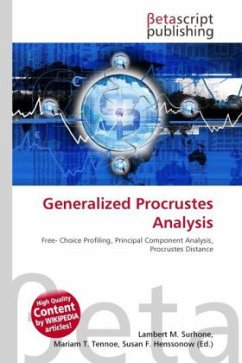
Generalized Procrustes Analysis
Versandkostenfrei!
Versandfertig in 6-10 Tagen
19,99 €
inkl. MwSt.

PAYBACK Punkte
10 °P sammeln!
High Quality Content by WIKIPEDIA articles! The origin of generalized Procrustes analysis (GPA) has a strong basis in the comparison of research results across languages (terms from interviews, surveys, panels, etc). It was developed to permit statistical analysis of the results of free-choice profiling which allows respondents (such as sensory panelists) to develop their own terms for attributes that describe a range of products in their own words or language (Meullenet, Xiong, and Findlay, 2007). GPA is the only way to make sense of free-choice profiling data. Generalized Procrustes analysis...
High Quality Content by WIKIPEDIA articles! The origin of generalized Procrustes analysis (GPA) has a strong basis in the comparison of research results across languages (terms from interviews, surveys, panels, etc). It was developed to permit statistical analysis of the results of free-choice profiling which allows respondents (such as sensory panelists) to develop their own terms for attributes that describe a range of products in their own words or language (Meullenet, Xiong, and Findlay, 2007). GPA is the only way to make sense of free-choice profiling data. Generalized Procrustes analysis estimates the scaling factor applied to respondent scale usage, thus it generates a weighting factor that is used to compensate for individual scale usage differences. Unlike measures such as a principal component analysis, since GPA uses individual level data, a measure of variance is utilized in the analysis.












